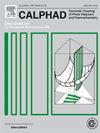1673K 下 CaO/SiO2 重量比为 1.2 的 FetO-TiO2-CaO-SiO2 体系中的相平衡关系
IF 1.9
3区 材料科学
Q4 CHEMISTRY, PHYSICAL
Calphad-computer Coupling of Phase Diagrams and Thermochemistry
Pub Date : 2024-11-14
DOI:10.1016/j.calphad.2024.102768
引用次数: 0
摘要
在氩气环境下,采用高温平衡法,通过电子探针 X 射线显微分析(EPMA)和 X 射线衍射(XRD)测量,在 1673K 温度下确定了 CaO/SiO2 重量比为 1.2 的 FetO-TiO2-CaO-SiO2 体系中的相平衡关系。研究发现,该体系中存在 7 种晶相和 1 种液相,这 8 种相之间存在 19 种不同的相平衡关系。这 7 种晶相分别是:千层岩(Ca3Si2O7)、乌尔沃斯宾石(Fe3-xTixO4)、假沸石(FeO-2TiO2)、钛铁矿(FeTiO3)、透辉石(CaTiO3)、金红石(TiO2)和武氏石(FetO)。用 L 表示液相,K 表示千长石,U 表示乌洛托品石,B 表示假沸石,I 表示钛铁矿,P 表示透辉石,R 表示金红石,W 表示绿泥石,这些相形成的 19 种相平衡关系可归纳如下:1) 单 L,2) L + U,3) L + R,4) L + W,5) L + K,6) L + I,7) L + B,8) L + P,9) L + R + P,10) L + I + P,11) L + B + I、12)L + R + B,13)L + U + W,14)L + U + I,15)L + U + P,16)L + P + B,17)L + U + I + P,18)L + R + B + P,19)L + B + I + P。最后,根据上述确定的相平衡关系,构建了 1673K 时体系的剖面相图。从所构建的相图中,我们可以看到成分变化所引起的相的演化过程。本文章由计算机程序翻译,如有差异,请以英文原文为准。
Phase equilibria relationship in the FetO-TiO2-CaO-SiO2 system with CaO/SiO2 weight ratio of 1.2 at 1673K
Phase equilibria relationship in the FetO-TiO2-CaO-SiO2 system with CaO/SiO2 weight ratio of 1.2 under argon atmosphere were identified experimentally at 1673K by employing high-temperature equilibration method followed by electron probe X-ray microanalysis (EPMA) and X-Ray Diffraction (XRD) measurements. It was found that there exist 7 crystal phases and 1 liquid phase in the system, and 19 different kinds of phase equilibria relationship exist among these 8 phases. The 7 crystal phases are as follows: kilchoanite (Ca3Si2O7), ulvöspinel (Fe3-xTixO4), pseudobrookite (FeO·2TiO2), ilmenite (FeTiO3), perovskite (CaTiO3), rutile (TiO2) and wüstite (FetO). By using L as the symbol for liquid phase, K for kilchoanite, U for ulvöspinel, B for pseudobrookite, I for ilmenite, P for perovskite, R for rutile and W for wüstite, the 19 phase equilibria relationships formed by these phases can be summarized as follows: 1) single L, 2) L + U, 3) L + R, 4) L + W, 5) L + K, 6) L + I, 7) L + B, 8) L + P, 9) L + R + P, 10) L + I + P, 11) L + B + I, 12) L + R + B, 13) L + U + W, 14) L + U + I, 15) L + U + P, 16) L + P + B, 17) L + U + I + P, 18) L + R + B + P, and 19) L + B + I + P. Finally, based on the above-determined phase equilibria relationship, a section phase diagram of the system at 1673K was constructed. From the constructed phase diagram, the evolution of phases caused by composition change can be seen graphically.
求助全文
通过发布文献求助,成功后即可免费获取论文全文。
去求助
来源期刊
CiteScore
4.00
自引率
16.70%
发文量
94
审稿时长
2.5 months
期刊介绍:
The design of industrial processes requires reliable thermodynamic data. CALPHAD (Computer Coupling of Phase Diagrams and Thermochemistry) aims to promote computational thermodynamics through development of models to represent thermodynamic properties for various phases which permit prediction of properties of multicomponent systems from those of binary and ternary subsystems, critical assessment of data and their incorporation into self-consistent databases, development of software to optimize and derive thermodynamic parameters and the development and use of databanks for calculations to improve understanding of various industrial and technological processes. This work is disseminated through the CALPHAD journal and its annual conference.

 求助内容:
求助内容: 应助结果提醒方式:
应助结果提醒方式:


